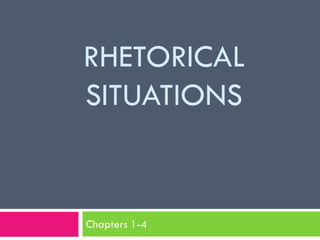
Rhetorical Situations
- 2. Wait a minute…. What is RHETORIC?????
- 3. RHETORIC The purposeful use of language in speech or in writing In other words…the ways in which you, the speaker or the writer, purposely use language in different situations. Different situations require different language!
- 4. Rhetorical Situation A situation in which you use You think about the situation before you words to communicate. choose your rhetoric. Choose your words wisely Think before you speak (OR WRITE)
- 5. Rhetorical Situations Everywhere In the following four slides, you will see various rhetorical situations that you might come across at home, at work, at play, and at school. Consider each rhetorical situation on the slide. •How do the situations differ? •How would you consider your choice of words in each situation? Why?
- 6. Rhetorical Situations Everywhere At home
- 7. Rhetorical Situations Everywhere At work
- 8. Rhetorical Situations Everywhere At play
- 9. Rhetorical Situations Everywhere At School
- 10. Rhetorical Situation There are five elements to consider in EVERY rhetorical situation Purpose – why are you communicating? Audience – who is listening/reading? ELEMENTS TO Stance – what is your attitude? CONSIDER Genre – what kind of writing are you using? Media & Design – print, spoken, or digital?
- 11. Elements to Consider Now let’s look at each element of a rhetorical situation a little closer.
- 12. CONSIDER YOUR PURPOSE Why are you writing? To express yourself To entertain To communicate with others To persuade To inform Some situations have one purpose, others have several.
- 13. CONSIDER YOUR AUDIENCE IDENTIFY YOUR AUDIENCE…Who will read (or hear) what you are writing? Are they known or unknown? Is your audience one person or multiple? These (and more) questions will help shape the words that you choose and how you convey your message.
- 14. CONSIDER YOUR AUDIENCE What is your audience’s background? What are their interests? Is there any demographic information you should keep in mind? What political circumstances should you consider? What does your audience already know about your topic? What is your relationship with your audience? What does your audience need/expect from you?
- 15. CONSIDER YOUR STANCE Or in other words…What is your attitude toward your topic? But…It’s not just what you say, but how you say it!
- 16. CONSIDER YOUR STANCE It’s not just what you say, but how you say it. TONE = HOW YOU SAY IT Thoughtful vs. Defiant Objective vs. Opinionated Sarcastic vs. Serious Assertive vs. Uncertain How do you choose the right TONE? Ask the following questions: Who is your audience? What is your purpose?
- 17. CONSIDER THE GENRE What genre will you choose to communicate (in writing)??? Letter Profile Report Position Paper Poem Instructions Web Pages
- 18. Rhetorical Situations: Practice Now it’s time for some practice. Carefully look at the following slides and decide the rhetorical situation in each. “A likely impossibility is always preferable to an unconvincing possibility.” – Plato Poetics What do you think???
- 19. Analyze the Rhetorical Situation
- 20. Analyze the Rhetorical Situation
- 21. Analyze the Rhetorical Situation
- 22. Analyze the Rhetorical Situation
- 23. The Rhetorical Situation AND The Writing Process There are 5 Steps to the Writing Process Pre-Writing Writing Revising Proofreading Submission One Question: When do you start to think about the rhetorical situation? Begin to think about it during the pre-writing phase – before you actually start writing. Re-visit the topic throughout the writing and revising steps to make sure you are on the right track.